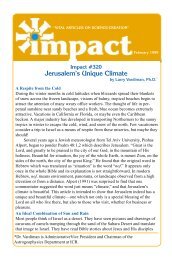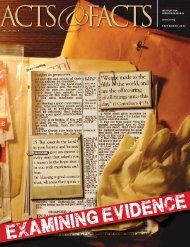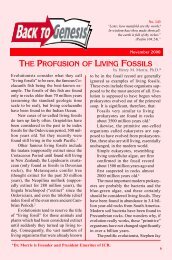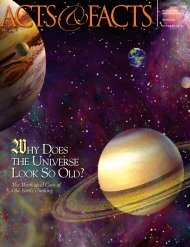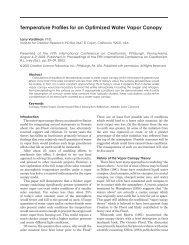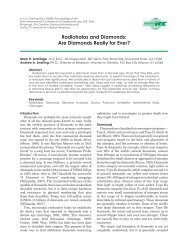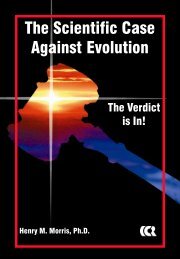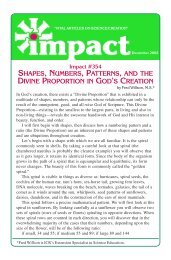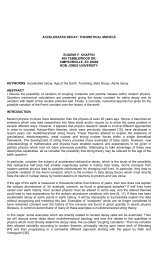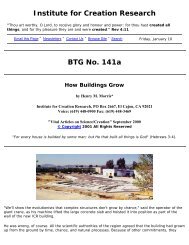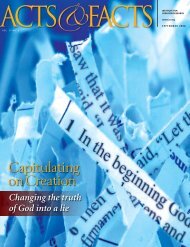Download April 2008 PDF - Institute for Creation Research
Download April 2008 PDF - Institute for Creation Research
Download April 2008 PDF - Institute for Creation Research
You also want an ePaper? Increase the reach of your titles
YUMPU automatically turns print PDFs into web optimized ePapers that Google loves.
Christians<br />
in Space<br />
Explorer 1 launch<br />
Many alive today have witnessed the entire history of<br />
space flight. Anyone who looked up to see Sputnik<br />
cross the sky on October 4, 1957, remembers the panic<br />
that set in across the country. The thought of communists<br />
beating us to space was intolerable. American prestige sank to a new<br />
low when Vanguard, the Navy’s attempt to launch a satellite into orbit on<br />
December 6, blew up on the launch pad be<strong>for</strong>e the watching world. The<br />
turning point in the race came with America’s first success, Explorer 1,<br />
on January 31, 1958—50 years ago. Two key figures in this achievement<br />
became bold Christians in the years that followed.<br />
Though technical success in space is a collective achievement, the<br />
title “father of the space program” or “world’s greatest rocket scientist”<br />
could defensibly be given to Wernher von Braun. 1 Only von Braun took<br />
space exploration from childhood dreams to reality. By his death in 1977,<br />
his rockets had taken man to the moon and probes to Mars, Venus, and<br />
Mercury, with the Voyagers en route to the outer planets.<br />
In 1962, an engineer led Dr. von Braun to Christ using a Gideon<br />
Bible. Upon praying to repent of sin and receive Christ, the eminent<br />
rocket scientist confessed that he felt like a great burden had been lifted<br />
off him. He became a fervent Christian, and prayed <strong>for</strong> the success of his<br />
launches. As Apollo 11 lifted off the pad, he was found reciting the Lord’s<br />
Prayer. Never pushy about his faith, he spoke openly about it when asked.<br />
In 1972, he wrote to the Cali<strong>for</strong>nia school board to argue <strong>for</strong> inclusion of<br />
non-evolutionary views in science classes. Popular magazine articles by<br />
von Braun discussed science’s dependence on Christian faith.<br />
Another man behind the success of Explorer 1 was Dr. Henry L.<br />
Richter, Jr. (Ph.D., Caltech), the Group Supervisor of Explorer Design<br />
Courtesy NASA/JPL-Caltech.<br />
DaViD F. CoPPeDGe<br />
and Development. After Explorer 1’s success, he continued work on the<br />
Ranger, Mariner, and Surveyor programs, eventually leaving JPL <strong>for</strong> private<br />
enterprise and consulting. During those same years of the 1960s, Dr.<br />
Richter recognized his need <strong>for</strong> the Lord and later became a committed<br />
Christian. Recently, he published a small book that describes the wonders<br />
of life and the universe. 2 Richter explains how these intricate designs could<br />
not have evolved. The book, which defends a young-earth position, ends<br />
with a call to receive the gospel of Jesus Christ.<br />
I received a surprise call from Dr. Richter this past December. At<br />
the time, I did not know who he was. Dr. Richter said he had read some<br />
of my articles in ICR’s magazine<br />
and wanted to get acquainted,<br />
since he was coming to the lab to<br />
work on a documentary film. On<br />
the day we met, I was astonished<br />
to learn he was a key player in the<br />
mission that brought America to<br />
space. Now 80 years old and still<br />
sharp, he fascinated me with tales<br />
of those adventurous days.<br />
A month later, on January<br />
30, JPL had a big 50th-year<br />
anniversary celebration <strong>for</strong> all<br />
employees. Dr. Richter was an<br />
honored guest among dozens of<br />
octogenarian retirees who came<br />
<strong>for</strong> the occasion. I heard him give<br />
a speech to employees about Explorer<br />
1. He ended with a bold<br />
testimony about how he came to<br />
have a glorious relationship with<br />
the Designer of the universe.<br />
I can testify from experience<br />
that there are many Chris-<br />
tians in the space program. They may not write the press releases, but they<br />
are there. They do excellent work, witnessing as they can in a mostly secularist/evolutionary<br />
environment. Like followers of Jesus Christ in all walks<br />
of life, they are the salt and light of the planet.<br />
References<br />
1. Although Dr. von Braun’s research was co-opted by Germany<br />
during World War II, von Braun himself was never a supporter<br />
of Nazism.<br />
2. Henry L. Richter, Jr., PhD, PE. 2006. The Universe: A Surprising<br />
Cosmological Accident. Longwood, FL: Xulon Press.<br />
David Coppedge works in the Cassini Program at the Jet Propulsion<br />
Laboratory. The views expressed are his own.<br />
A model of Explorer 1, held by JPL’s Director<br />
William Pickering, scientist James Van<br />
Allen, and rocket pioneer Wernher von<br />
Braun (from left to right). The team was<br />
gathered at a news conference at the National<br />
Academy of Sciences in Washington,<br />
D.C., to announce the satellite’s successful<br />
launch. America’s first satellite, Explorer 1<br />
had launched a few hours be<strong>for</strong>e, on January<br />
31, 1958, at 10:48 p.m. EST.<br />
APRIL <strong>2008</strong> • ACTS&FACTS<br />
15<br />
Courtesy NASA/JPL-Caltech



